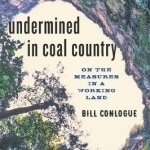Undermined in Coal Country: On the Measures in a Working Land
BookThis item doesn’t have any media yet
2017 | History & Politics
Deep mining ended decades ago in Pennsylvania's Lackawanna Valley. The barons who made their fortunes have moved on. Low wages and high unemployment haunt the area, and the people left behind wonder whether to stay or seek their fortunes elsewhere. Once dominated by the boom-and-busts of coal mining, the valley's shared history touches communities as far-flung as the Pacific Northwest, the Gulf Coast shorelines, and the mountains of West Virginia. Bill Conlogue explores how two overlapping coal country landscapes-Scranton, Pennsylvania, and Marywood University-have coped with the devastating aftermath of mining. Examining the far-reaching environmental effects of mining, including heavy deforestation, geological disruption, and mine fires, this beautifully written book asks bigger questions about what it means to influence a landscape to this extent-and then to live in it. In prose rivaling that of Annie Dillard and John McPhee, Conlogue describes a fascinating paradox: because of coal mining, the city and college have suffered, but the United States has grown stronger.
Examining higher education through the lens of an unstable region still reeling from its industrial heritage, Undermined in Coal Country defends the study of literature and history as parts of an interdisciplinary web of meaning. Conlogue argues that, if we are serious about solving environmental problems, if we are serious about knowing where we are and what happens there, we need to attend closely to all places-that is, to attend to the world in a cold, dark, and disorienting universe. Unearthing new ways of thinking about place, pedagogy, and the environment, this meditative text reveals that place is inherently unstable.
Related Items:
| Published by | Johns Hopkins University Press |
| Edition | Unknown |
| ISBN | 9781421423180 |
| Language | N/A |
Images And Data Courtesy Of: Johns Hopkins University Press.
This content (including text, images, videos and other media) is published and used in accordance
with Fair Use.
